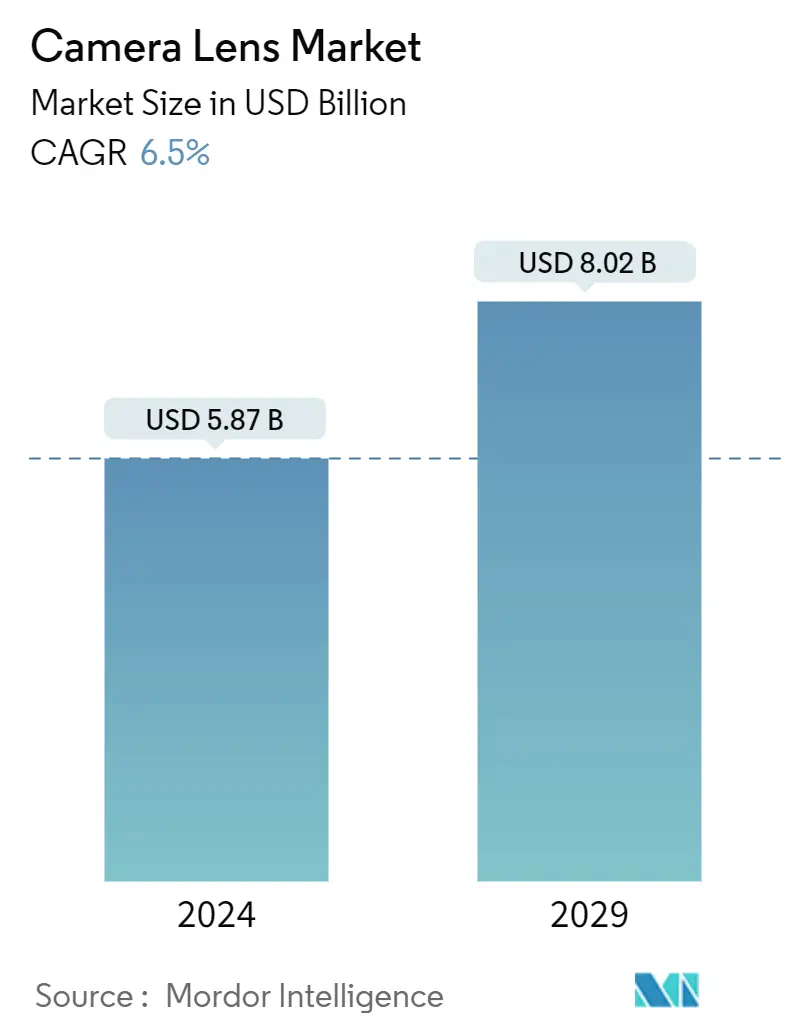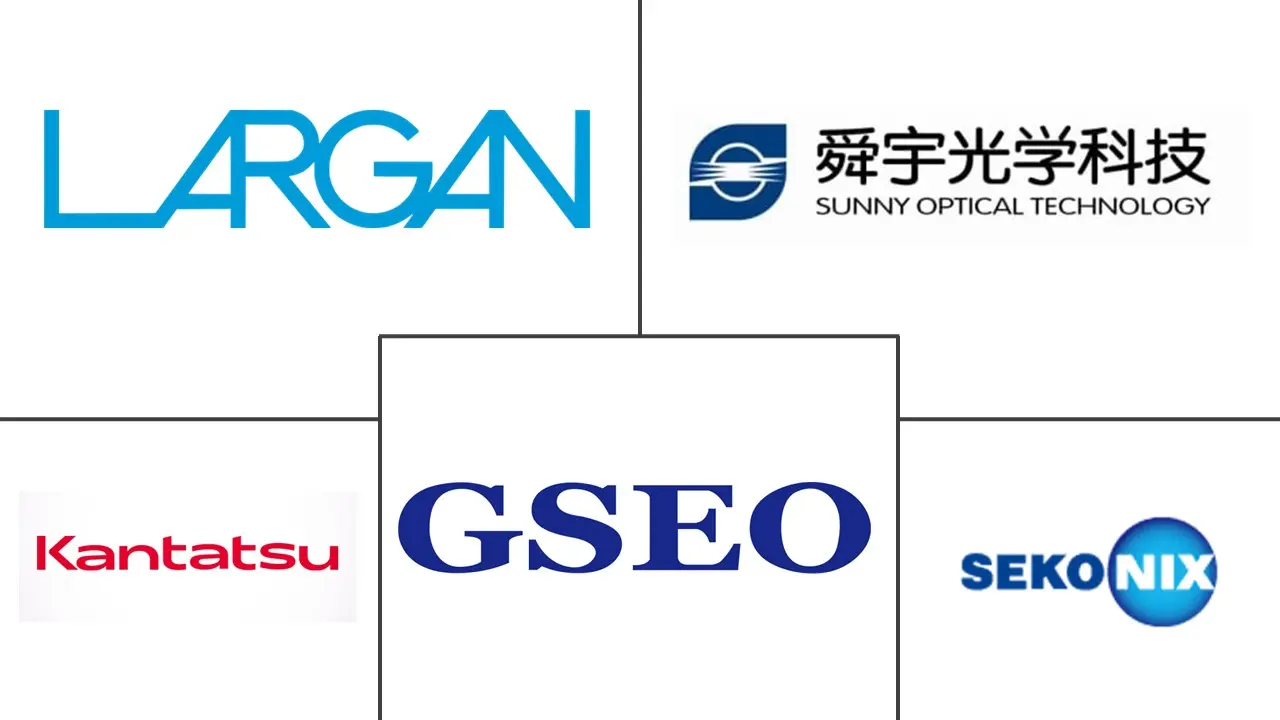Market Size of Camera Lens Industry

| Study Period | 2019 - 2029 |
| Market Size (2024) | USD 5.87 Billion |
| Market Size (2029) | USD 8.02 Billion |
| CAGR (2024 - 2029) | 6.50 % |
| Fastest Growing Market | Asia Pacific |
| Largest Market | Asia Pacific |
| Market Concentration | Low |
Major Players
*Disclaimer: Major Players sorted in no particular order |
Camera Lens Market Analysis
The Camera Lens Market size is estimated at USD 5.87 billion in 2024, and is expected to reach USD 8.02 billion by 2029, growing at a CAGR of 6.5% during the forecast period (2024-2029).
A camera lens is an optical body that facilitates a single lens or a collection of lenses that mount to a camera body. Various lenses are interchangeable, while others are built into the camera’s construction. Modern lenses always look forward to setting the angle of incidence and the angle of refraction to equal values to minimize aberration and feature a focus element that permits the operator to dictate which portions of the image are sharp and which are blurred.
- Recent advances in smartphone camera technology have focused on improving the optical performance of the lens, as well as incorporating additional features such as visual image stabilization and advanced autofocus systems. These improvements have helped make smartphone cameras more capable and opened up many mobile photography and videography possibilities.
- The adoption of smartphones equipped with professional-grade cameras has steadily increased. Prime factors responsible for the market's growth include advancements in smartphone camera technology and the rising demand for social media platforms for attractive visual content. Smartphone manufacturers have significantly advanced camera technology, allowing them to incorporate high-quality lenses, sensors, and image processing capabilities. These advancements have bridged the gap between traditional cameras and smartphones, enabling users to capture professional-grade photos and videos with their smartphones. These advancements include larger sensors, multiple lenses, optical image stabilization, advanced autofocus systems, and computational photography techniques. These features enable smartphones to capture high-quality images with robust detail, dynamic range, and low-light performance.
- Camera lenses play a crucial role in autonomous vehicles by providing visual information about the vehicle’s surroundings. Cameras are fixed on all four sides of the car (front, rear, right, and left) to provide a comprehensive 360-degree view of the vehicle’s surroundings. This allows the car to detect obstacles, pedestrians, and other vehicles nearby.
- Manufacturing camera lenses on a large scale presents several challenges. These challenges include designing and fabricating lens elements, ensuring optical quality, managing production costs, and meeting market demands. The design and fabrication of lens elements are crucial steps in the manufacturing process.
- The COVID-19 pandemic significantly impacted the electronics industry because of the halt in production. This led to increased demand for electronics and semiconductor products in various sectors. The effects of COVID-19 include widespread disruption of manufacturing in Europe and a halt in the export of Chinese parts. These factors adversely impacted the global cameral lens market.
Camera Lens Industry Segmentation
A camera lens is an optical device that focuses and captures light to create an image. It is an essential camera component and plays a crucial role in determining the quality and characteristics of the photographs taken. Several types of camera lenses are available, each with unique features and applications. Some lenses include the Prime Lens, Zoom Lens, Wide-angle Lens, Telephoto Lens, and Macro Lens. In a film camera, the lens sends the light to the film strip, while in a digital camera (like DSLR or mirrorless camera), the lens directs light to a digital sensor.
The study tracks the revenue accrued through the sale of the camera lens market by various players across applications, including consumer electronics, automotive, and medical in the global market. The study also tracks the key market parameters, underlying growth influencers, and major vendors operating in the industry, which supports the market estimations and growth rates over the forecast period. The study further analyses the overall impact of COVID-19 aftereffects and other macroeconomic factors on the market. The report’s scope encompasses market sizing and forecasts for the various market segments.
The camera lens market is segmented by application (consumer electronics [mobile, AR/VR/MR, other consumer electronics], automotive, medical, other applications), by geography (North America, Europe, Asia-Pacific, Latin America, Middle East & Africa). The report offers the market size in value terms in USD for all the abovementioned segments.
| By Application | |||||
| |||||
| Automotive | |||||
| Medical | |||||
| Other Applications |
| By Geography | |
| North America | |
| Europe | |
| Asia-Pacific | |
| Latin America | |
| Middle East & Africa |
Camera Lens Market Size Summary
The camera lens market is poised for significant growth, driven by advancements in smartphone camera technology and the increasing demand for high-quality visual content on social media platforms. Modern camera lenses, whether interchangeable or built-in, are designed to minimize aberrations and allow for precise focus control, enhancing image quality. The integration of advanced features such as optical image stabilization, multiple lenses, and computational photography techniques in smartphones has blurred the lines between traditional cameras and mobile devices, enabling users to capture professional-grade photos and videos. This trend is further supported by the growing adoption of smartphones with professional-grade cameras, which is expected to continue as consumers prioritize photography and videography capabilities in their purchasing decisions.
The Asia-Pacific region plays a crucial role in the camera lens market, driven by its status as a major hub for smartphone manufacturing and a burgeoning automotive sector. The region's demand for advanced smartphone camera lenses is fueled by a large consumer base and a rapidly developing telecom sector. Additionally, the automotive industry's need for camera lenses in autonomous vehicles contributes to market growth. The market is characterized by fragmentation, with key players like Largan Precision Co., SEKONIX, and Sunny Optical engaging in strategic activities such as mergers, acquisitions, and product launches to expand their market presence. Recent innovations in lens technology, including new lens models and imaging solutions, further underscore the dynamic nature of the market, offering promising prospects for future growth.
Camera Lens Market Size - Table of Contents
-
1. MARKET DYNAMICS
-
1.1 Market Drivers
-
1.1.1 Growing Adoption of Smartphones Equipped with Professional Grade Cameras
-
1.1.2 Increased Usage of Camera Lens in Autonomous Vehicles
-
-
1.2 Market Challenges
-
1.2.1 Mass Manufacturing Challenges
-
1.2.2 Decreasing Profit Margins in the Industry
-
-
-
2. MARKET SEGMENTATION
-
2.1 By Application
-
2.1.1 Consumer Electronics
-
2.1.1.1 Mobile
-
2.1.1.2 AR/VR/MR
-
2.1.1.3 Other Consumer Electronics
-
-
2.1.2 Automotive
-
2.1.3 Medical
-
2.1.4 Other Applications
-
-
2.2 By Geography
-
2.2.1 North America
-
2.2.2 Europe
-
2.2.3 Asia-Pacific
-
2.2.4 Latin America
-
2.2.5 Middle East & Africa
-
-
Camera Lens Market Size FAQs
How big is the Camera Lens Market?
The Camera Lens Market size is expected to reach USD 5.87 billion in 2024 and grow at a CAGR of 6.5% to reach USD 8.02 billion by 2029.
What is the current Camera Lens Market size?
In 2024, the Camera Lens Market size is expected to reach USD 5.87 billion.

